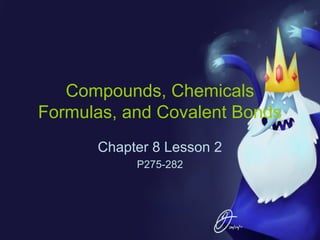
Ch 8.2
- 1. Compounds, Chemicals Formulas, and Covalent Bonds Chapter 8 Lesson 2 P275-282
- 2. Review • Compounds are substances made up of two of more different elements • Compounds and the elements that make them up often have different properties • Chemical bonds join atoms together. • One way atoms from bonds is by sharing valence electrons
- 3. Covalent Bonds – Sharing Electrons • When unstable, nonmetal atoms bond together, they bond by sharing valence electrons. • A covalent bond is a chemical bond formed when two atoms share one or more pairs of valence electrons. • The atoms then form a stable covalent compound
- 4. A Noble Gas Electron Arrangement • An atoms with less than eight valence electrons becomes stable by forming chemical bonds until it has eight valence electrons. • The most chemically stable state for most atoms has the electron configuration of a noble gas. • Look at H2O
- 5. H2O Bonding
- 6. Shared Electrons • If the oxygen atom and each hydrogen atom share their unpaired valence electrons, they can form two covalent bonds and become a stable covalent compound. • Each covalent bond contains two valence electrons. • Since these electrons are shared, they count as valence electrons for both atoms in the bond. • In H2O, all three atoms combine sharing valence electrons. We know the compound is stable because all three atoms have eight valence electrons.
- 7. Double and Triple Covalent Bonds • A single covalent bond exists when two atoms share one pair of valence electrons. • Double bonds exist when two atoms share two pairs of valence electrons. – Double bonds are stronger than single bonds • Triple covalent bonds exist when two atoms share three pairs of valence electrons. – Triple bonds are stronger than double bonds.
- 9. Covalent Compounds • Covalent compounds usually have low melting points and low boiling points. • They are usually gases or liquids at room temperature, but they can also be solids • Covalent compounds are poor conductors of thermal energy and electricity
- 10. Molecules • A molecule is a group of atoms held together by covalent boning that acts as an independent unit, • Table sugar (C12H22O11) is a covalent compound. • One grain of sugar is made up of trillions of sugar molecules. • One molecule of sugar contains 12 carbon atoms, 22 hydrogen atoms, and 11 oxygen atoms. • The only way to break a molecule of sugar would be to chemically separate the atoms of C, H, and O.
- 11. Water and Other Polar Molecules • In a covalent bond, one atom can attract the shared electrons more strongly than the other atoms can. • Consider H2O – The oxygen atom attracts the shared electrons more strongly than each hydrogen atom does. – As a result, the shared electrons are pulled closer to the oxygen atom. – Since electrons have a negative charge, the oxygen atom has a partial negative charge. • A molecule that has a partial positive end and a partial negative end because of unequal sharing of electrons is a polar molecule.
- 14. Dissolving Molecules • The charges on a polar molecule affect its properties. • Sugar dissolves easily in water because sugar and water are polar. • The negative ends of a water molecule pulls on the positive end of a sugar molecule. • Also, the positive end of a water molecule pulls on the negative end of the sugar molecule. • This causes the sugar molecules to separate from one another and mix with the water molecules.
- 16. Nonpolar molecules • A hydrogen molecule, H2, is a nonpolar molecule. • Hydrogen atoms are identical, their attraction for a shared electron is equal. • The carbon dioxide molecule, CO2, is also nonpolar. • A nonpolar compound will not easily dissolve in a polar compound, but it will dissolve easily in a nonpolar compound. • Oil is an example of a nonpolar compound. It will not dissolve in water.
- 18. Chemical Formulas and Molecular Models • A chemical formula is a group of chemical symbols and numbers that represent the elements and the number of atoms of each element that make up a compound. • Just as a recipe lists ingredients, a chemical carbon dioxide is CO2. formula lists the elements in a compound. • For example, the chemical formula for – CO2 is made up of carbon and oxygen atoms. – The subscript, or small number after a chemical symbol, shows the number of atoms of each element in the compound. – CO2 contains two atoms of oxygen bonded to one atom of carbon.
- 19. •st as a recipe lists ingredients, a chemical formula lists the elements in a compound. For exa Chemical Formulas and Molecular Models • When parentheses (“()”) are used, any subscript applies to all the elements inside the parentheses. • Example: – Al2(SO4)3 • 2 Aluminum • 3 Sulfur • 12 Oxygen
